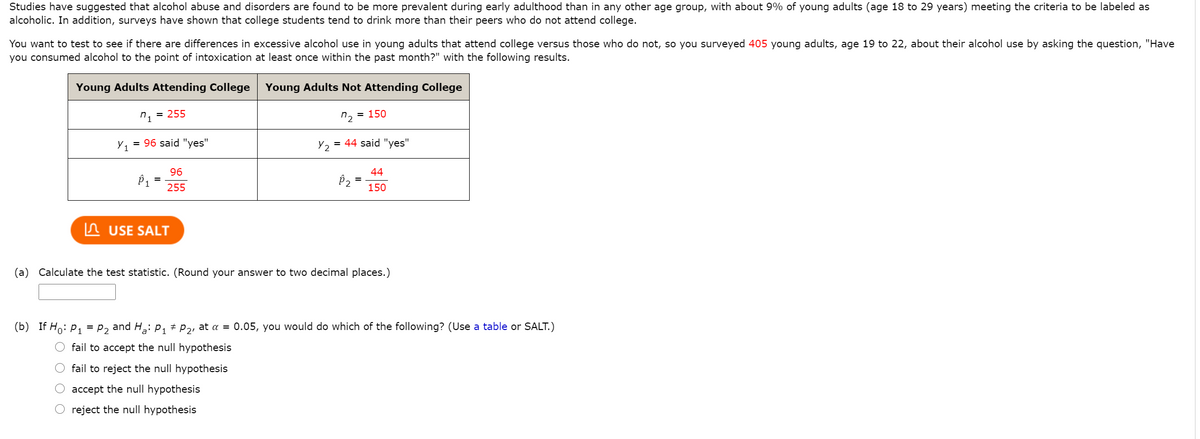Studies have suggested that alcohol abuse and disorders are found to be more prevalent during early adulthood than in any other age group, with about 9% of young adults (age 18 to 29 years) meeting the criteria to be labeled as alcoholic. In addition, surveys have shown that college students tend to drink more than their peers who do not attend college. You want to test to see if there are differences in excessive alcohol use in young adults that attend college versus those who do not, so you surveyed 405 young adults, age 19 to 22, about their alcohol use by asking the question, "Have you consumed alcohol to the point of intoxication at least once within the past month?" with the following results. Young Adults Attending College Young Adults Not Attending College n, = 255 n, = 150 = 96 said "yes" Y2= 44 said "yes" 96 P1 = P2 = 255 150 n USE SALT (a) Calculate the test statistic. (Round your answer to two decimal places.) (b) If Ho: P - P2 and H: P, P2, at a = 0.05, you would do which of the following? (Use a table or SALT.) O fail to accept the null hypothesis O fail to reject the null hypothesis O accept the null hypothesis O reject the null hypothesis
Addition Rule of Probability
It simply refers to the likelihood of an event taking place whenever the occurrence of an event is uncertain. The probability of a single event can be calculated by dividing the number of successful trials of that event by the total number of trials.
Expected Value
When a large number of trials are performed for any random variable ‘X’, the predicted result is most likely the mean of all the outcomes for the random variable and it is known as expected value also known as expectation. The expected value, also known as the expectation, is denoted by: E(X).
Probability Distributions
Understanding probability is necessary to know the probability distributions. In statistics, probability is how the uncertainty of an event is measured. This event can be anything. The most common examples include tossing a coin, rolling a die, or choosing a card. Each of these events has multiple possibilities. Every such possibility is measured with the help of probability. To be more precise, the probability is used for calculating the occurrence of events that may or may not happen. Probability does not give sure results. Unless the probability of any event is 1, the different outcomes may or may not happen in real life, regardless of how less or how more their probability is.
Basic Probability
The simple definition of probability it is a chance of the occurrence of an event. It is defined in numerical form and the probability value is between 0 to 1. The probability value 0 indicates that there is no chance of that event occurring and the probability value 1 indicates that the event will occur. Sum of the probability value must be 1. The probability value is never a negative number. If it happens, then recheck the calculation.
| Young Adults Attending College | Young Adults Not Attending College | ||||
|---|---|---|---|---|---|
|
n1 = 255
|
n2 = 150
|
||||
|
y1 = 96
said "yes" |
y2 = 44
said "yes" |
||||
|
p̂1 =
|
p̂2 =
|

Trending now
This is a popular solution!
Step by step
Solved in 3 steps







